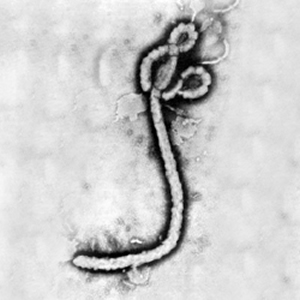HIV and Ebola are understandably two of the most feared diseases occurring in the world today. They are newcomers to medical science, but they are far from newcomers to humans and their primate ancestors in tropical Africa. Through surveys of wild animal populations and examination of viral DNA scientists have determined that these viruses have co-evolved with nonhuman host populations over millions of years. In their usual hosts, these viruses, like any well-adapted parasite, are rarely fatal and do not so debilitate the host that it is unable to reproduce.
This is not the case with humans. We evidently do not easily contract either disease from animals, but once the species gap is bridged, the consequences can be devastating. When a human falls ill with Ebola, a ghastly hemorrhagic fever rapidly ensues, and people in close contact with the sufferer must take stringent precautions to avoid infection. The very high fatality rate for Ebola and the related Marburg virus is anomalous in a population with a history of exposure. Usually, extremely high death rates in epidemics occur only with introduced diseases, for example, smallpox among Native Americans. Over time, natural selection favors less virulent strains of the pathogen and more resistant hosts. Why has this not occurred with Ebola and Homo sapiens?
The answer to this riddle may lie in AIDS. HIV infections develop slowly, and individuals are infective long before obvious symptoms of disease appear. Were this not so, it could never become established in a population, because transmission involves intimate person to person contact and aversion to sex with an obviously diseased partner is a basic instinct, not limited to humans.
However, as AIDS infection progresses, a person becomes more likely to be infected with an animal pathogen to which humans with normal immune systems are resistant, and also less likely to recover from any serious bacterial or viral infection he contracts. Therefore, the presence in the environment of a rapidly lethal pathogen can act as a brake against the spread of AIDS, by removing carriers before they have time to infect others.
In urban environments, infection with animal pathogens such as Ebola is less likely, but a similar equilibrium between AIDS and serious epidemic diseases may still prevail. The highest rates of AIDS infection worldwide are not in central Africa, but in South Africa and countries historically tied to it (Botswana, Swaziland, Lesotho). Public health measures to curb the most serious contagious diseases are generally better in these countries than in equatorial Africa.
The idea that there is a stable equilibrium between HIV and Ebola/Marburg in equatorial Africa would help explain another epidemiological anomaly. Some people carry a variant of a receptor gene which confers resistance to HIV. People with two copies of this gene are immune, and those with one copy develop immunodeficiency symptoms much more slowly than non-carriers. Logically, one would expect the variant to be commonest where AIDS is endemic, but in fact, it’s commonest in northwestern Europe and absent in central Africa. If the improved survivorship of people with one copy of the gene enables them to spread HIV to more partners, and to offspring, then it should be selected against, but only in the presence of serious contagious diseases.
Image Credits
“Ebola Virus” from utmb Health Virus Images/Foundations of Virology
“Marburg Virus” from utmb Health Virus Images/Foundations of Virology




Please Share Your Thoughts - Leave A Comment!